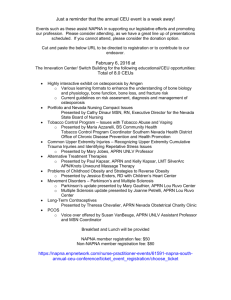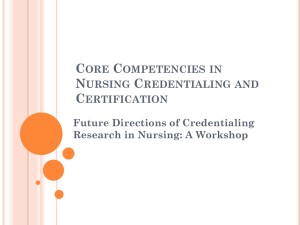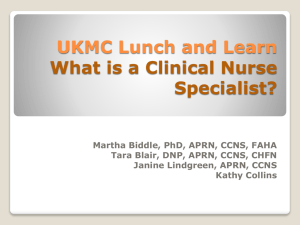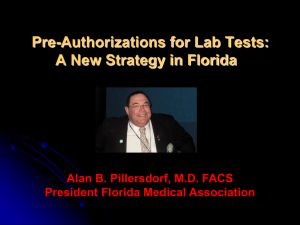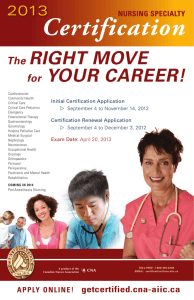The Consensus Model for - American Association of Critical
advertisement
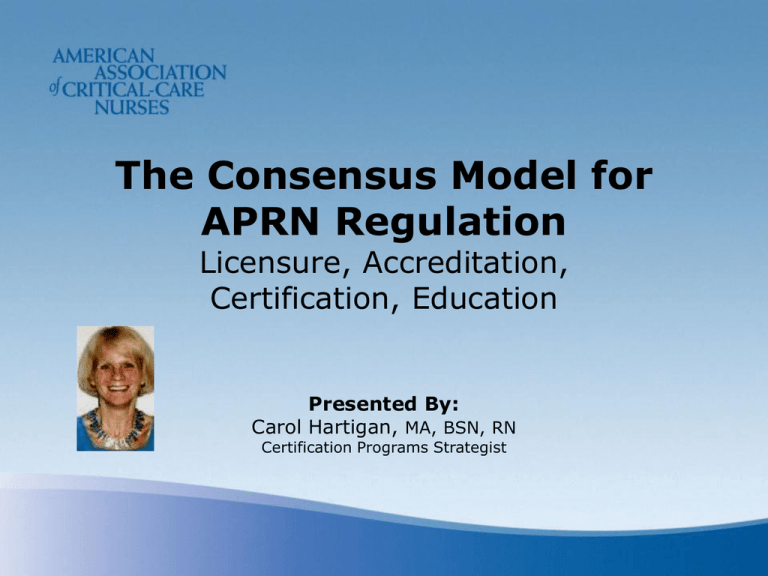
The Consensus Model for APRN Regulation Licensure, Accreditation, Certification, Education Presented By: Carol Hartigan, MA, BSN, RN Certification Programs Strategist “Heard” on social media… “By 2015, all Clinical Nurse Specialists will need to have their DNP in order to keep practicing.” “This credentialing controversy only gets more complicated as they change the exams and the credentials given out. ALL should be accepted equally. ” “Georgia has reached out to the National Council of State Boards of Nursing and other professional organizations requesting they intervene as currently half the CNSs in the state are forced back into school and/or clinical so they can sit for certification exams. “The Consensus Model regulations are aimed more at making money for the Universities by requiring more education than benefiting patient care which is the ultimate goal.” Webinar Objectives • Identify how the Consensus Model for APRN Regulation will change the practice of CNSs or NPs • Discuss nursing program curricula changes needed to be ready for the new regulatory model by the 2015 deadline • For students going forward • For current CNSs • Consider opportunities to positively influence implementation of the model in your educational program 1. What do the Consensus Model for APRN Regulation and the AACN-Colleges DNP Initiative have in common? 2. What are the components of a certification examination which ensure regulatory sufficiency? 3. What steps would a currently-certified Adult Acute/Critical Care Nurse CNS take to become nationally certified as an Adult-Gerontology Acute Care Nurse CNS? 4. When will the Boards of Nursing begin to require the DNP to take the certification exams? Key Regulatory Issues in Advanced Practice http://journals.lww.com/aacnadvancedcriticalcare/Fulltext/2011/01000/APRN_Regula tion__The_Licensure_Certification.8.aspx Who and How to Regulate? Medicine Nursing Who and How to Regulate? Medicine Nursing Who and How to Regulate? Registered Nurse Advanced Practice Registered Nurse Who and How to Regulate? Primary Care APRN Acute Care APRN Who and How to Regulate? Neonatal Pediatric Adult Gero Regulatory Concerns • Inconsistency across APRN educational programs • Lack of knowledge of/control over APRN certification examination programs • “Proliferation of subspecialties” • Practice beyond or outside of scope as determined by education and certification • Inconsistent enforcement of certification eligibility requirements Reaching Consensus Key Issues Identified • Who is an APRN? What characterizes APRN practice? • Primary care vs. Acute care – what are the differences and what is the overlap? • What are the similarities and what are the differences among the four roles related to educational preparation, scope of practice, educational accreditation and regulation? • How does the age of the patient fit into the population-focused model? • Where does “specialty” preparation fit in the model? • What is the best model for the future needs of patients and families? APRN Licensure How did we get here anyway? NCSBN Historical Position Statements and Activities 1986 – NCSBN adopts a position paper on Advanced Clinical Nursing Practice • Determines that the educational requirement should be a minimum of a Master’s degree and • The preferred method of regulation of advanced nursing is designation/ recognition 1993 - NCSBN adopts Model Legislative Language and Model Administrative Rules for Advanced Nursing Practice and the position paper on the regulation of advanced nursing practice • Moves the recommended method of regulation of advanced nursing from designation/recognition to licensure. This change was made due to the fact that the activities of the practitioners are complex, require specialized knowledge and skill, and independent decision making. There is an established scope of practice and prequalification for safe practice must be determined by licensing boards. Because of potential harm to the public, licensure affords the ability to discipline practitioners • Directs the Board of Directors continue collaboration with the American Nurses Association, American Association of Nurse Anesthetists, American College of Nurse-Midwives and other nursing organizations, including nurse certifying bodies. NCSBN Historical Position Statements and Activities 1994 - NCSBN performs a study to identify core competencies of nurse practitioners and a study exploring the regulatory, fiscal and political implications of developing a core competency examination for nurse practitioners. 1995 – NCSBN collaborates with NP certification organizations to move toward legally defensible examinations and processes and third-party accreditation. 2000 – NCSBN collaborates with APRN stakeholders to develop Uniform Advanced Practice Registered Nurse Licensure/Authority to Practice Requirements, which serve as the foundation for the APRN Compact. 2002 – NCSBN Board of Directors approves the Advanced Practice Advisory Committee’s Position Paper on the Regulation of Advanced Practice and the Requirements for Accrediting Agencies and the Criteria for Certification Programs which delineates required elements of certification programs that would result in a legally defensible examination suitable for the regulation of APRNs. History of the Model The Alliance for APRN Regulation • Established in 1997 by AACN-Colleges and CCNE as The Alliance for Nursing Accreditation • Goal to establish a framework and mechanism to foster collaboration among the regulatory bodies that oversee or review baccalaureate and graduate education • Original membership included: • • • • • • • • • • • • • American Academy of Nurse Practitioners Certification Program American Association of Colleges of Nursing American College of Nurse-Midwives Division of Accreditation American Nurses Credentialing Center Association of Faculties of Pediatric Nurse Practitioners Commission on Collegiate Nursing Education Council on Accreditation of Nurse Anesthesia Educational Programs National Certification Corporation National Council of State Boards of Nursing National Organization of Nurse Practitioner Faculties National Association of Nurse Practitioners in Women's Health, Council on Accreditation National Certification Board of Pediatric Nurse Practitioners & Nurses (Pediatric Nursing Certification Board) Added AACN Certification Corporation to membership in February 2002 and National Association of Clinical Nurse Specialists in October 2003 History of the Model The Alliance for APRN Regulation • In March 2004, AACN-Colleges and NONPF submitted a proposal to the Alliance to establish a process to develop a consensus statement on the credentialing of advanced practice nurses (APNs) • Thirty-two organizations participated in the APN Consensus Conference in June 2004 to initiate an in-depth examination of issues related to APN definition, specialization, sub-specialization, and regulation, which includes accreditation, education, certification and licensure. • A smaller work group made up of designees from twenty-three organizations with broad representation of APN certification, licensure, education, accreditation, and practice was charged with development of a statement that addressed the issues, delineated during the APN Consensus Conference with the goal of envisioning a future model for APNs. History of the Model Parallel Processes • The Alliance APN Consensus Work Group convened for sixteen days of intensive discussion between October 2004 and July 2007 to develop a working model. • In a parallel process, the National Council of State Boards of Nursing (NCSBN) APRN Advisory Panel had been drafting an APRN Vision Paper to provide direction to boards of nursing regarding APRN regulation for the next 8-10 years by identifying an ideal future APRN regulatory model. • The NCSBN Board of Directors disseminated the draft Vision Paper to Boards of Nursing and APRN stakeholders in April 2006 for feedback. • A Joint Dialogue Group consisting of representatives from the APRN Consensus Work Group and the NCSBN APRN Advisory Panel convened to craft one, consensus-based APRN regulatory document which would be future-oriented and promote patient safety and public protection. • Report of the Joint Dialogue Group was agreed to by both stakeholder groups and released on July 7, 2008. Boards of Nursing Endorse Consensus Model through Model Documents https://www.ncsbn.org/Article_XVIII_1.31.11.pdf NCSBN Model Nurse Practice Act APRN Scope of Nursing Practice • APRNs are expected to practice as licensed independent practitioners within standards established and/or recognized by the BON. Each APRN is accountable to patients, the nursing profession and the BON for complying with the requirements of this Act and the quality of advanced nursing care rendered; for recognizing limits of knowledge and experience; planning for the management of situations beyond the APRN’s expertise; and for consulting with or referring patients to other health care providers as appropriate. APRNs are accountable for: • Health promotion • Assessment, diagnosis, and management of patient problems • Which includes the use and prescription of pharmacologic and non-pharmacologic interventions An APRN is an individual who has: • Completed an accredited graduate-level educational program • Passed a national certification examination that matches the educational preparation • Acquired advanced clinical skills and knowledge An APRN is an individual who has: • Practice built upon the competencies of a RN • Clinical experience of sufficient depth and breadth to reflect the intended license • Obtained a license to practice as an APRN in one of the four roles • Advanced clinical knowledge and skills to provide direct care to patients is a defining component of practice • All APRNs have a significant component of education and practice focusing on direct care of individuals APRN Regulatory Model Licensure occurs at Levels of Role & Population Foci APRN Specialties Focus of Practice beyond role and population focus Linked to health care needs Examples include but are not limited to: Oncology, Older Adults, Orthopedics, Nephrology, Palliative care POPULATION FOCI Family/Individual Across lifespan AdultGerontology Women’s Health/ Gender Related Neonatal Pediatrics Psych/Mental Health APRN ROLES Nurse Anesthetist Nurse Midwife Clinical Nurse Specialist ++ Nurse Practitioner + +The certified nurse practitioner (CNP) is prepared with the acute care CNP competencies and/or the primary care CNP competencies. At this point in time the acute care and primary care CNP delineation applies only to the pediatric and adultgerontology CNP population foci. Scope of practice of the primary care or acute care CNP is not setting specific but is based on patient care needs. Program may prepare individuals across both the primary care and acute care CNP competencies. If programs prepare graduates across both sets of roles, the graduate must be prepared with the consensus-based competencies for both roles and must successfully obtain certification in both the acute and the primary care CNP roles. CNP certification in the acute care or primary care roles must match the educational preparation for CNP’s in these roles. ++The Clinical Nurse Specialist (CNS) is educated and assessed through national certification processes across the continuum from wellness through acute care. + The Clinical Nurse Specialist (CNS) is educated and assessed through national certification processes across the continuum from wellness through acute care. …just a few words about the clinical nurse specialist role for those with blended and/or postgraduate programs… +Nurse Practitioner • The certified nurse practitioner (CNP) is prepared with the acute care CNP competencies and/or the primary care CNP competencies. • At this point in time the acute care and primary care CNP delineation applies only to the pediatric and adult-gerontology CNP population foci. +Nurse Practitioner • Scope of practice of the primary care or acute care CNP is not setting specific but is based on patient care needs. • Programs may prepare individuals across both the primary care and acute care CNP competencies. +Nurse Practitioner • If programs prepare graduates across both sets of roles, the graduate must be prepared with the consensus-based competencies for both roles and must successfully obtain certification in both the acute and the primary care CNP roles. CNP certification in the acute care or primary care roles must match the educational preparation for CNPs in these roles. For entry into APRN practice and for regulatory purpose the APRN education must: • Be a formal accredited graduate or post-graduate certificate program in an academic institution. The program must be comprehensive and on the graduate level • Be awarded pre-approval, pre-accreditation or accreditation status prior to admitting students • Prepare graduates in one of four roles and in at least one of the population foci For entry into APRN practice and for regulatory purpose the APRN education must: • Include at least three separate comprehensive graduate level courses in the APRN core • Advanced Physiology/Pathophysiology • Advanced Health Assessment • Advanced Pharmacology For entry into APRN practice and for regulatory purpose the APRN education must: • Provide basic understanding of decision-making principles • Ensure clinical and didactic coursework is comprehensive to prepare the graduate to practice in the APRN role and population foci • More focused area of practice than role and population foci • Specialty preparation cannot replace educational preparation in the role or one of the six population foci • Specialty preparation cannot expand one’s scope of practice beyond the role and population focus • Addresses a subset of the population-focus • Definition built on ANA (2004) Criteria for Recognition as a Nursing Specialty • The title may not be used in lieu of the licensing title, which includes the role and population • Is developed, recognized and monitored by the profession APRN regulation includes: – Licensure • The granting of authority to practice – Accreditation • Formal review and approval by a recognized agency of educational degree or certification programs in nursing or nursing related programs – Certification • The formal recognition of knowledge, skills and experience demonstrated by the achievement of standards identified by the profession – Education • The formal preparation of APRNs in graduate or postgraduate programs Boards of Nursing will: • License APRNs in one of four roles with a population focus • Be solely responsible for licensing (exception for states where boards of midwifery regulate nursemidwives and midwives) • Only license graduates of accredited graduate programs Boards of Nursing will: • Require successful completion of a national certification examination that assesses APRN core, role and population competencies • Only license an APRN when education and certification are congruent • Not issue a temporary license • License APRNs as independent practitioners with no regulatory requirements for collaboration, direction or supervision Boards of Nursing will: • Have at least one APRN representative position on the board and utilize an APRN advisory committee that includes representatives of all four APRN roles • Institute a grandfathering clause that will exempt those APRNs already practicing in the state from new eligibility requirements • Have the option for mutual recognition of advanced practice nursing through the APRN Compact Accreditors will: • Evaluate APRN graduate degree and post-graduate certification programs • Through their established accreditation standards and process, assess APRN education programs in light of the APRN core, role core and population core competencies Accreditors will: • Assess developing APRN education programs and tracks by reviewing them using established accreditation standards and granting pre-approval, preaccreditation or accreditation prior to student enrollment • Include an APRN in the visiting team when reviewing an APRN program • Monitor the APRN education programs throughout the accreditation period Foundational Requirements for Certification Certification programs providing APRN Certification used for licensure will: • Follow established certification testing and psychometrically sound, legally defensible standards for APRN examinations for licensure • Assess the APRN core and role competencies across at least one population focus of practice • Assess specialty competencies separately from the APRN core, role and population focused competencies (example: AdultGerontology CNS and Oncology CNS will take two separate certification examinations) Foundational Requirements for Certification Certification programs providing APRN Certification used for licensure will: • Be accredited by a national certification accreditation body (ABNS or NCCA; role of NCSBN APRN Committee) • Enforce congruence between the education program and the type of certification examination - exam name matches transcript Key Elements - Certification Educational eligibility requirements met: • 3 Ps • Required number of didactic courses in population focus • Sufficient supervised clinical hours in population focus • Educational program prepared graduate to be eligible to sit for the nationally recognized certification that corresponds to the APRN role and population focus for which the student was prepared in the program. • Degree awarded on transcript matches examination name APRN educational programs/tracks leading to eligibility for a APRN license will: • Follow established educational standards and ensure attainment of the APRN core, role core and population core competencies • Be accredited by a nursing accrediting organization that is recognized by the U.S. Department of Education and/or the Council for Higher Education Accreditation APRN educational programs/tracks leading to eligibility for a APRN license will: • Be pre-approved, pre-accredited, or accredited prior to the acceptance of students, including all developing APRN education programs and tracks • Ensure that graduates of the program are eligible for national certification and state licensure • Ensure that official documentation (e.g. transcripts) specifies the role and population focus of the graduate RN Licensure Model • Initial licensure is based on a combination of individual jurisdictional requirements (criminal background, good moral character, etc.), prescribed educational qualifications and successful completion of national examination. • Depending on statutory authority, Board of Nursing may or may not perform individual “approval” of pre-licensure educational programs. Five individual state boards of nursing are separately recognized as accrediting agencies by the U.S. Department of Education. • Some jurisdictions consider approval of educational programs an accountability that may not be delegated to another entity; not all Boards of Nursing have statutory oversight of APRN educational programs, and not all APRN programs are located within schools of nursing. RN Licensure Model • All US Boards of Nursing utilize the NCLEX-RN examination. • Boards are afforded the option to periodically review NCLEXRN exam “forms” for compliance with their state practice acts. • Board members and staff may participate as volunteers on NCSBN examination committees and Boards nominate NCLEX item writers and exam development committee members, so in this way are active participants and stakeholders in their licensure exams. Changes to the passing standard must be approved by the NCSBN Board of Directors. • Changes in exam fees, test plans and eligibility requirements are determined by the NCSBN Delegate Assembly. It’s a Whole New Ballgame • Certification examinations become “high stakes” exams with accompanying legal vulnerabilities. • Certifiers enter into agreements with individual Boards of Nursing as Boards “delegate state authority” for assuring educational eligibility. • Graduate faculty are now accountable for preparing students for professional licensure examinations where in many instances this had not previously been the case (mostly CNS programs and other APRN types in states where national certification is not required for practice). It’s a Whole New Ballgame • Career mobility, tele-health initiatives, interstate ACOs, delayed retirement and consulting opportunities increase the likelihood that APRNs may need to qualify for licensure in other jurisdictions throughout the course of their careers, making it essential that all educational eligibility requirements are met, fully documented, and that documentation is retained for future use. • Educational eligibility requirements vary from vague to extremely detailed, depending on the jurisdiction; graduates must be qualified for licensure in any state, not just the state in which they are educated. Why Does It Matter? What difference does it make whether or not a is a CNS is categorized as an APRN in my state, as long as I have title protection? • Employment opportunities • Reimbursement • Salary Regulatory Sufficiency For a licensure or certification examination to meet the standards for regulatory sufficiency, it must meet the following criteria: 1. Be targeted to entry level practice 2. Measure only job-related knowledge, skills, and abilities 3. Require demonstration of competence at the minimum level necessary for safe and effective practice 4. Be psychometrically sound Get with the Guidelines • AACN-Colleges Master’s or Doctoral Essentials • NCSBN Criteria for APRN Certification Programs • Adult-Gerontology Clinical Nurse Specialist Competencies • AACN – Critical-Care Scope & Standards of Practice for the Clinical Nurse Specialist in Acute and Critical Care • Other Population-based or Specialty-focused Scope & Standards documents Get with the Guidelines • National Consensus Core CNS Competencies • NACNS Criteria for the Evaluation of Clinical Nurse Specialist Master’s, Practice Doctorate, and PostGraduate Certificate Educational Programs • State Nurse Practice Acts and Administrative Rules • AACN Certification Corporation Adult-Gerontology, Pediatric and Neonatal Acute Care Clinical Nurse Specialist Job Analyses and Test Plans and/or American Nurses Credentialing Center’s Adult-Gerontology and Pediatric Clinical Nurse Specialist Job Analyses and Test Plans when available. Adult-Gerontology CNS Competencies New CNS Resource Docs Consensus Model Based CNS Examinations and Test Plans Moving Forward How Do I Get From Here to There? Adult Acute and Critical Care CNS G A P Adult-Gero Acute Care CNS What Do I Have to Take? From NONPF NP NTF Criteria: (exemplar) III.F Post-master’s students must successfully complete graduate didactic and clinical requirements of a master’s NP program through a formal graduate level certificate or master’s level NP program in the desired area of practice. Postmaster’s students are expected to master the same outcome criteria as master’s NP students. Postmaster’s students who are not already NPs are required to complete a minimum of 500 supervised clinical hours. What Do I Have to Take? • Special consideration should be given to NPs expanding into another NP population-focused area of practice by allowing them to challenge selected courses and experiences; however, didactic and clinical experiences shall be sufficient to allow the student to master the competencies of the new area of NP practice. • These students must complete a sufficient number of clinical hours to establish competency in the new population-focused area of practice. • Programs should be able to document waivers and exceptions for individual students through a gap analysis. NTF Criteria Appendix F What Do I Have to Take? From NACNS Criteria for the Evaluation of Clinical Nurse Specialist Master’s, Practice Doctorate, and Post-Graduate Certificate Educational Programs: • Post-graduate certificate program graduates are expected to meet the same CNS competencies as master’s or practice doctorate program graduates. • Evidence that validates a minimum of 500 clinical (clock) hours in the master’s and post-graduate certificate CNS program. New Exam Timeline AACN Certification Corporation • Adult-Gerontology, Pediatric and Neonatal wellness-throughacute care CNS Analyses completed and Test Plans posted at http://www.aacn.org/WD/Certifications/Content/APRN-CNSProgram-Resources.pcms?menu=certification • Pilot testing of the new examinations will begin with selected groups of senior students begins in February 2013. • New exam release scheduled for June 2013 with instant scoring if sufficient numbers of pilot testers are recruited. • Current Adult, Pediatric and Neonatal CCNS exams will be administered through December 31, 2014. Current CCNS credential will be maintained as long as there are current certificants in practice who require it. 1. What do the Consensus Model for APRN Regulation and the AACN-Colleges DNP Initiative have in common? 2. What are the components of a certification examination which ensure regulatory sufficiency? 3. What steps would a currently-certified Adult Acute/Critical Care Nurse CNS take to become nationally certified as an Adult-Gerontology Acute Care Nurse CNS? 4. When will the Boards of Nursing begin to require the DNP to take the certification exams? Audience Questions Contact Us Please let us know if you would like more information, have suggestions for us, or would like to get involved as we “relentlessly communicate” details and updates about the implementation of the Consensus Model for APRN Regulation. AACN Certification Corporation (800) 899-2226 or certcorp@aacn.org
